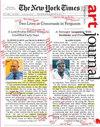Spatial Orders for the Masses
IF 0.3
3区 艺术学
0 ART
引用次数: 0
Abstract
activism, [and] climate sensing techniques” (8). This expansion reverberates with other recent scholarship such as Heather Houser’s Infowhelm: Environmental Art and Literature in an Age of Data (Columbia University Press, 2020), which frames data visualizations and climate predictions as matters of aesthetics and speculation—that is, as humanistic, not just technoscientific, endeavors. Further, contributors to the Companion insist that art and visual cultures have a unique role to play in an era of climate crisis. For one thing, while “nobody can feel average temperatures,” Schneider argues that art “can make this and other ways of perceiving the climate crisis possible” (264, emphasis in original)—given its general capacities to “sensitize[e] us, or mak[e] us more sensitive, to the world around us” (149). Sara Mameni agrees, calling the “aesthetic act” “a configuration of experience that can create new modes of sensory perception, induce new forms of political subjectivity, and anticipate futures, that is, build other possible worlds” (93). Many others echo the latter part of that sentiment; the editors offer the premise that “the world-altering emergency of climate breakdown demands the emergence of new imaginaries, social formations, and societal organizing principles” (385, emphasis in original) and Issa concludes that “art and visual culture are where questions of futurity are best imagined and explored” (102). Beyond art’s capacities to sense, sensitize, and speculate, this collection articulates more specific functions. “I want to build the capacity to handle complex environmental, internal, and spiritual situations,” artist Simpson declares to Horton—to make humans feel “empower[ed]” and capable of “adapt[ing]” (317). Kanouse reflects on her performance art practice as “a process of trying one thing, and then another, evaluating the result, and then trying again”; such “practices of experimentation, iteration, and improvisation,” she asserts, are “necessary to move through the impasse of climate change” (162). Such takes are optimistic, even instrumentalist. But at least one contributor is concerned about the opposite: that much contemporary art and visual culture in the era of climate crisis entails the proverbial fiddling while the world (literally) burns. “Why make an installation about refugees being stuck at the border when you could design tools to cut through the fences?” John Jordan demands in another memorable, controversy-stoking chapter (390). I therefore wondered at first why he bothered to write this essay instead of designing such tools, but the answer soon becomes clear. Living in an autonomous “Zone to Defend” outside Nantes, France, which has been occupied for several years by activists opposing the construction of a new airport, Jordan sees himself as answering Michel Foucault’s call for an “art of living”: “When you no longer outsource your problems and needs, everyday life goes from being unthinking automatic behavior, to being a question of technique, of skill and grace: of art,” Jordan insists (395). Thus, his polemic-turnedpersonal-reportage is itself, arguably, a work of art. Beyond what art is or does—or could or should do—another question emerges from the collection: Who is it for? The obvious, general answer would be “humans,” but Inez Blanca van der Scheer’s chapter offers another answer in considering Jason deCaires Taylor’s statue series Vicissitudes, installed underwater in Grenada’s Molinere Bay. Van der Scheer explains how the work serves nonhumans figuratively as well as literally: the statues’ “immersion is performed as the inversion of the plunder of overfishing or the contamination of pollution,” while the statues themselves serve as “artificial reefs to assuage the threat to natural coral reefs from environmental distress, climate change, and tourism” (377). On the statues today, van der Scheer reports, sponges, algae, and other lifeforms thrive, in bright and brilliant shades.大众的空间秩序
这种扩张与最近的其他学术研究产生了共鸣,比如希瑟·豪瑟的《Infowhelm:数据时代的环境艺术与文学》(哥伦比亚大学出版社,2020年),该书将数据可视化和气候预测作为美学和推测的问题——也就是说,作为人文主义的,而不仅仅是技术科学的努力。此外,《指南》的作者坚持认为,在气候危机时代,艺术和视觉文化可以发挥独特的作用。一方面,虽然“没有人能感受到平均温度”,但施耐德认为,艺术“可以使这种和其他感知气候危机的方式成为可能”(264,强调原文)——因为它具有“使我们对周围的世界敏感,或使我们对周围的世界更加敏感”(149)的一般能力。Sara Mameni对此表示赞同,她将“审美行为”称为“一种经验的配置,它可以创造新的感官知觉模式,诱导新的政治主体性形式,并预测未来,即建立其他可能的世界”(93)。其他许多人也赞同这种观点的后半部分;编辑们提出了一个前提,即“气候崩溃的紧急情况改变了世界,需要新的想象、社会形态和社会组织原则的出现”(385,强调原文),伊萨得出结论,“艺术和视觉文化是对未来问题最好的想象和探索”(102)。除了艺术的感知、敏感和推测能力之外,这个系列还表达了更具体的功能。“我想建立处理复杂环境、内心和精神状况的能力,”艺术家辛普森对霍顿说——让人类感到“被赋予了权力”,有能力“适应”(317页)。卡努斯将她的行为艺术实践反思为“一个尝试一件事,然后另一件事,评估结果,然后再尝试的过程”;她断言,这种“实验、迭代和即兴创作的实践”是“克服气候变化僵局所必需的”(162)。这样的看法是乐观的,甚至是工具主义的。但至少有一位撰稿人担心的是相反的情况:在气候危机时代,许多当代艺术和视觉文化都需要在世界(字面上)燃烧时进行众所周知的摆弄。“当你可以设计工具来穿越栅栏时,为什么要制作一个关于难民被困在边境的装置?”约翰·乔丹在另一个令人难忘、引发争议的章节(390)中问道。因此,一开始我想知道他为什么不辞辛苦地写这篇文章,而不是设计这样的工具,但答案很快就变得清晰起来。住在法国南特郊外一个自治的“防御区”,这里已经被反对建设新机场的激进分子占领了好几年,乔丹认为自己是在回应米歇尔·福柯(Michel Foucault)对“生活艺术”的呼吁:“当你不再把你的问题和需求外包出去时,日常生活就从无意识的自动行为变成了一个技术、技巧和优雅的问题:艺术,”乔丹坚持(395)。因此,他的论战式的个人报告文学可以说是一件艺术作品。除了艺术是什么、能做什么、应该做什么之外,还有一个问题从这些藏品中浮现出来:它是为谁而存在的?显而易见,一般的答案是“人类”,但伊内兹·布兰卡·范德希尔的章节提供了另一个答案,考虑到杰森·德卡莱斯·泰勒的雕塑系列沧桑,安装在格林纳达的莫里内雷湾水下。范·德·舍尔解释了这件作品是如何既从字面上也从比喻上为非人类服务的:雕像的“浸入式表演是对过度捕捞或污染污染的掠夺的反转”,而雕像本身则是“人工珊瑚礁,以减轻环境困扰、气候变化和旅游业对自然珊瑚礁的威胁”(377)。范德谢尔说,在今天的雕像上,海绵、藻类和其他生命形式在明亮明亮的阴影中茁壮成长。
本文章由计算机程序翻译,如有差异,请以英文原文为准。
求助全文
约1分钟内获得全文
求助全文

 求助内容:
求助内容: 应助结果提醒方式:
应助结果提醒方式:


